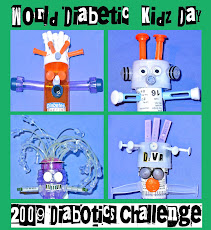While we enjoyed our early experiments with gluc, tape and polymer clay, our quest to use as little as possible extra material (and to have less constantly sticky hands) led us to try out other ways to join pieces together. It wasn't self-evident that it would work - making a hole in one piece of plastic and simply jabbing in another. Our results, however, impressed us substantially. The stretchiness of glucose tubes, for example, gave a little "wiggle" room to slide in a syringe base. The highly polished, tapered and durable surfaces of medical plastic seem to lend themselves quite well to this technology. Any pieces that appeared less-than-fully secure could be glued afterward in a single, quick session.
The two most reliable ways we found to make consistent holes of a useful size were hole punches and rotary tools (though basic sharp pointed awls worked in a pinch).
Hole Punches
For little ones, a hole punch can be a useful way to make holes in glucose and similar tube containers. Comparably sized plastic pieces can simply be shoved in (obviously some experimentation is involved).
These plastic containers also lend themselves to being cut with a sharp blade like and X-Acto knife, which provide portals for lancet strips that youngsters can color and slide in.
Rotary Tool
We use a Dremel tool, though any rotary tool at all should work fine. It has proved to be the most versatile and helpful diabetology adjunct we have found so far. The attachments that have been most applicable are of a cutting variety (see the triangular pointed cutter and the perpendicular cutting blade in the photo below), though several interested diabetologists have experimented with grinding and sanding attachments to "rub off" product names. Rotary tools have become surprisingly affordable (for example, a 3 speed Black & Decker RTX-6 2 amp 3 speed rotary tool with 30 accessories and 2 spring clamps is available on Amazon with free shipping for $32.49 [less than half the original market price]).
Safety Issues
Rotary tools are a very appealing and engaging medium for preteen children and can be used by them quite skilfully under appropriate close adult supervision with safety measures in place. Safety glasses , good lighting and a cutting mat free of clutter are essentials. During the cutting process, pieces may get hot (in some cases, the tool almost melts through the plastic). It's important that kids be aware of this and avoid touching pieces that have been cut for half a minute or so.
While a cordless rotary tool is not essential, the Dremel cordless tool is a bit smaller and more easily handled by avant garde kids with smaller hands (and eliminates worry about cord tangles). Careful - your kids may find hundreds of new and previously-undescribed applications for rotary tools in their daily lives!
Rotary Tool Applications
We have used ours to punch holes in everything from pump site applicators to the tops of glucometer stick containers and to slice syringes and other cylindrical items into rings (great for glasses)
Spend some time playing with your available starting materials and see what you come up with! Pre-drilled pieces offer a path to instant gratification for younger kids to assemble diabotics.










No comments:
Post a Comment